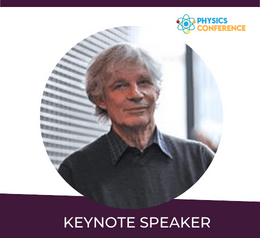Scholars International Conference on
PHYSICS AND QUANTUM PHYSICS
THEME: "Frontiers in Physics and Quantum Physics"
 22-23 Jun 2022
22-23 Jun 2022  NH Potsdam, Berlin, Germany & Online
NH Potsdam, Berlin, Germany & Online THEME: "Frontiers in Physics and Quantum Physics"
 22-23 Jun 2022
22-23 Jun 2022  NH Potsdam, Berlin, Germany & Online
NH Potsdam, Berlin, Germany & Online 
University of Pennsylvania and Institute for Systems Biology, Seattle, USA
Title: The Third Transition in Science
Kauffman presently holds a joint
appointment at the University of Calgary in Biological Sciences and in Physics
and Astronomy, and is an Adjunct Professor in the Department of Philosophy. He
is also an iCORE chair.
He graduated from Dartmouth in 1960, was awarded the BA (Hons) by Oxford University in 1963, and completed a medical degree (M.D.) at the University of California, San Francisco in 1968. After a brief medical career, he moved into developmental genetics, holding appointments first at the University of Chicago, then at the University of Pennsylvania from 1975 to 1995, where he rose to Professor of Biochemistry and Biophysics. Kauffman held a MacArthur Fellowship, 1987-1992.
Kauffman rose to prominence through his association with the Santa Fe Institute (a non-profit research institute dedicated to the study of complex systems), where he was faculty in residence from 1986 to 1997, and through his work on models in various areas of biology. These included autocatalytic sets in origin of life research, gene regulatory networks in developmental biology, and fitness landscapes in evolutionary biology.
In 1996, Kauffman started
BiosGroup, a Santa Fe, New Mexico-based for-profit company that employs complex
systems methodology to attempt to solve business problems. BiosGroup was
acquired by NuTech Solutions in early 2003.
Since Newton, all classical and quantum physics depends upon the “Newtonian Paradigm". Here the relevant variables of the system are identified. For example, we identify the position and momentum of classical particles. Laws of motion in differential form connecting the variables are formulated. An example is Newton's three Laws of Motion and Law of Gravitation. The boundary conditions creating the phase space of all possible values of the variables are defined. Then, given any initial condition, the differential equations of motion are integrated to yield an entailed trajectory in the pre-stated and fixed phase space. It is fundamental to the Newtonian Paradigm that the set of possibilities that constitute the phase space is always definable and fixed ahead of time.
All of this fails for the diachronic evolution of ever new adaptations in our, or any biosphere. The central reason is that living cells achieve Constraint Closure and construct themselves. With this, living cells, evolving via heritable variation and Natural selection, adaptively construct new in the universe possibilities. The new possibilities are opportunities for new adaptations thereafter seized by heritable variation and Natural Selection. Surprisingly, we can neither define nor deduce the evolving phase spaces ahead of time. The reason we cannot deduce the ever evolving phase spaces of life is that we can use no mathematics based on Set Theory to do so. We can neither write nor solve differential equations for the diachronic evolution of ever new adaptations in a biosphere.
These ever-new adaptations with ever-new relevant variables constitute the ever-changing phase space of evolving biospheres. Because of this, evolving biospheres are entirely outside the Newtonian Paradigm.
One consequence is that for any universe such as ours with one or more evolving biospheres, there can be no Final Theory that entails all that comes to exist. The implications are large. We face a third major transition in science beyond the Pythagorean dream that “All is Number", a view echoed by Newtonian physics.
In face of this, we must give up deducing the diachronic evolution of the biosphere. All of physics, classical and quantum, however, apply to the analysis of existing life, a synchronic analysis.
But there is much more. We begin to better understand the emergent creativity of an evolving biosphere. Thus, we are on the edge of inventing a physics-like new statistical mechanics of emergence.